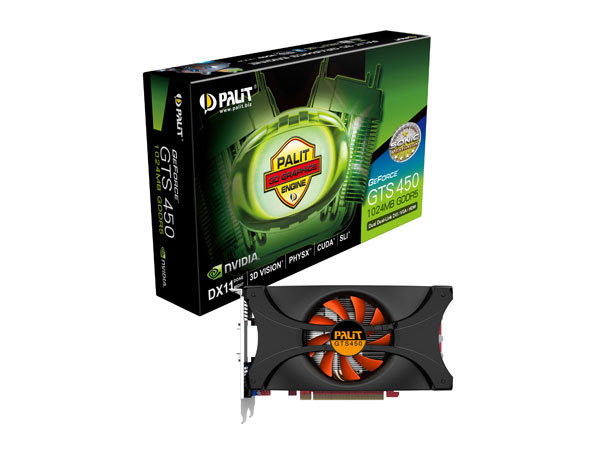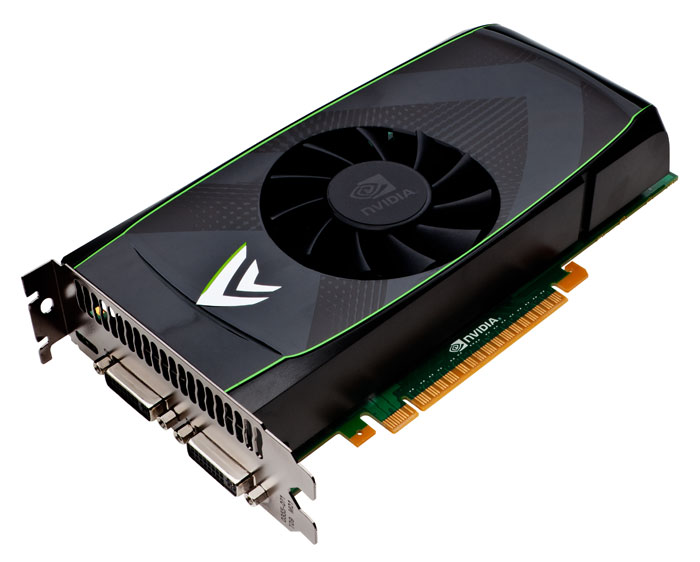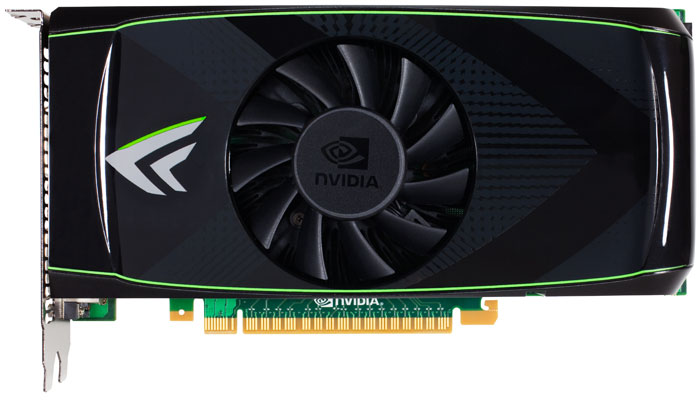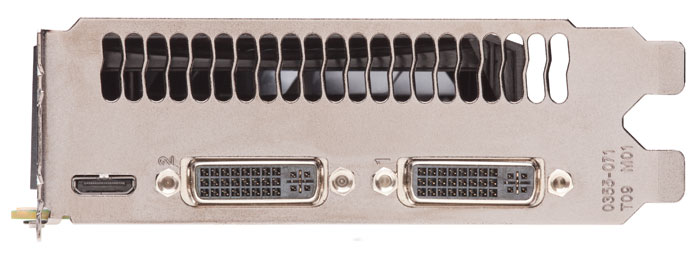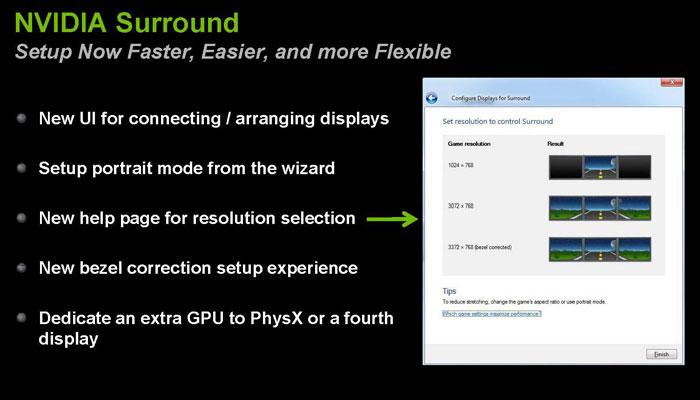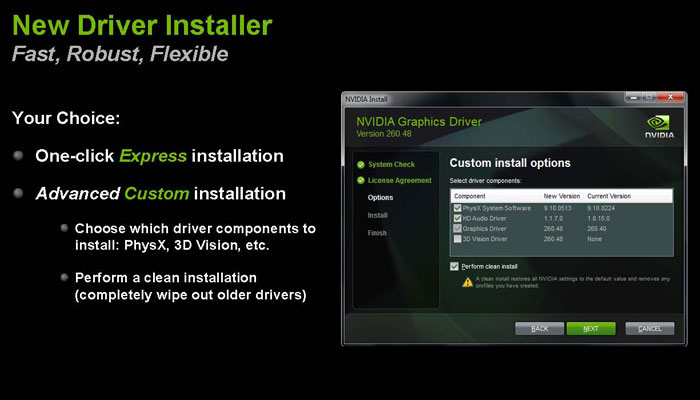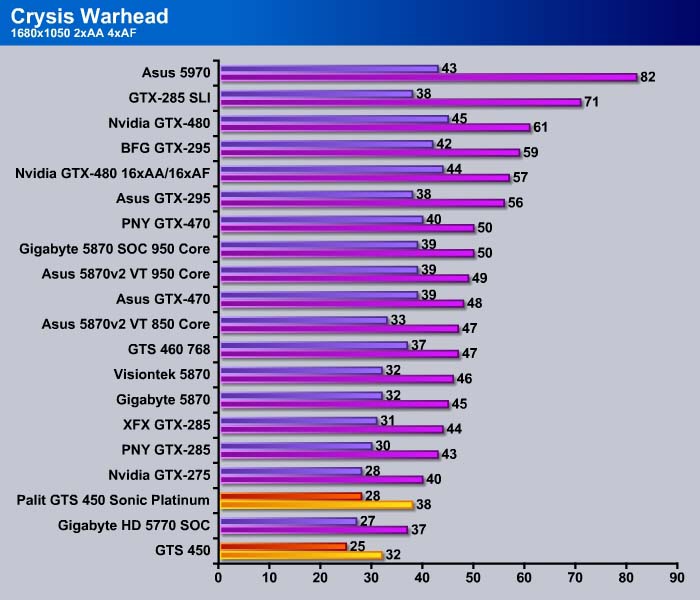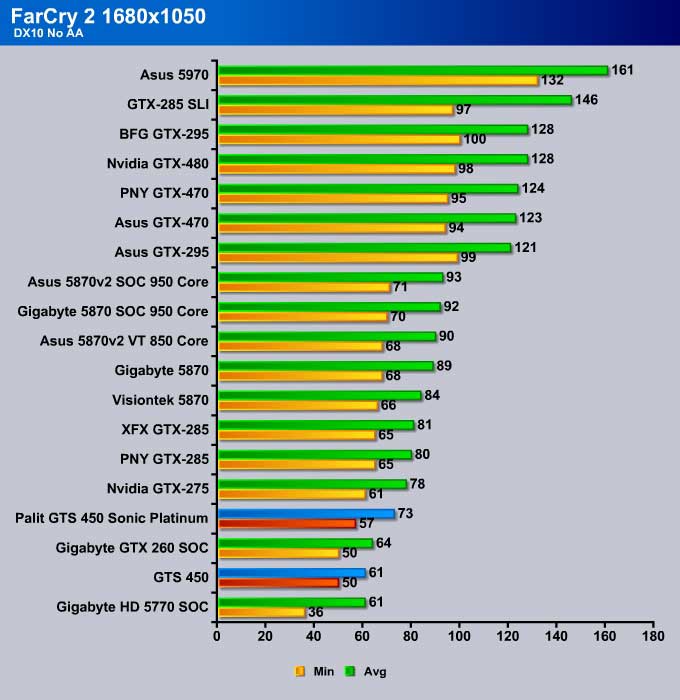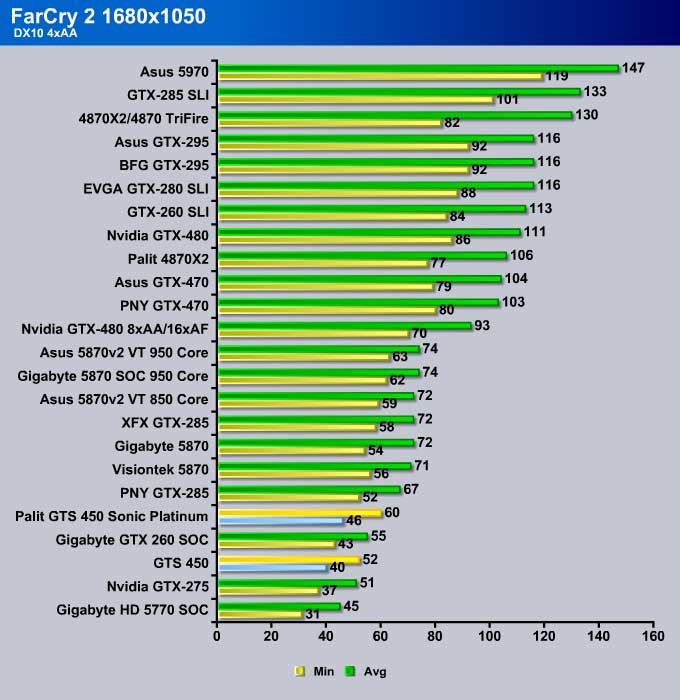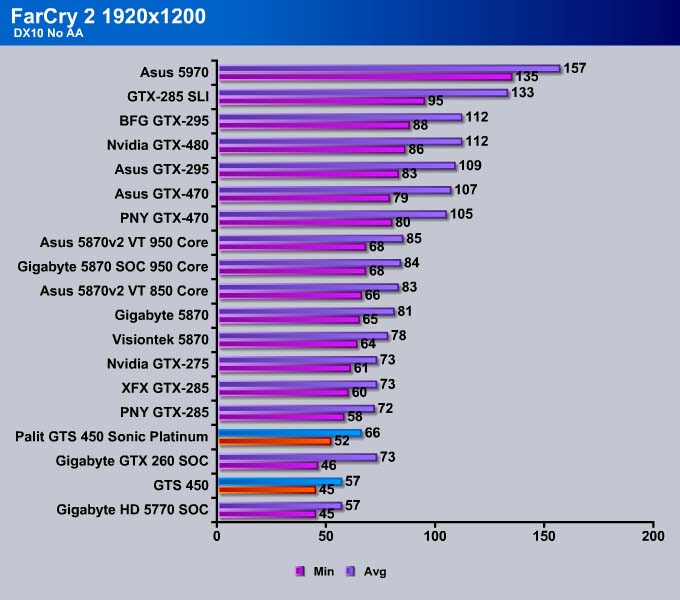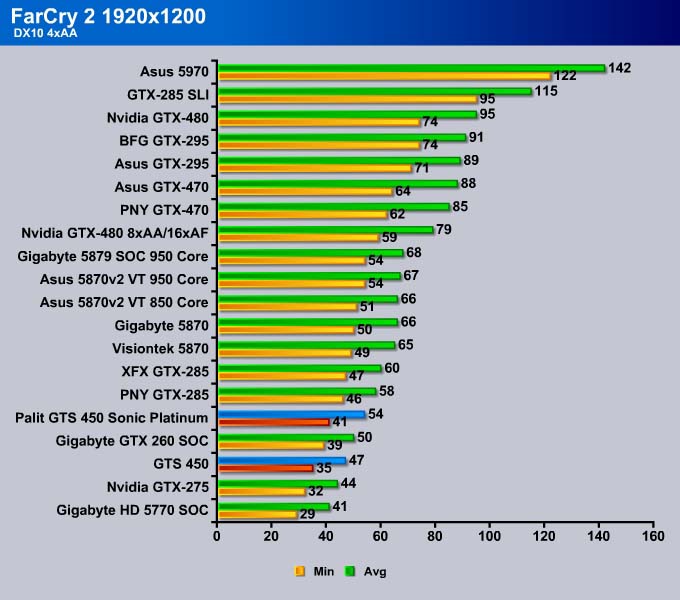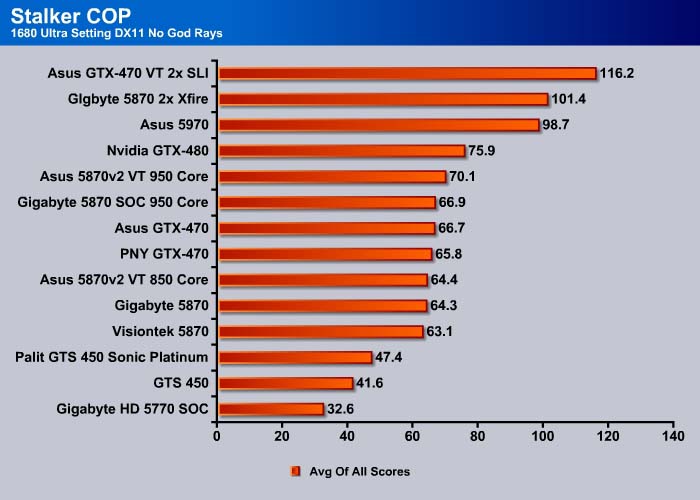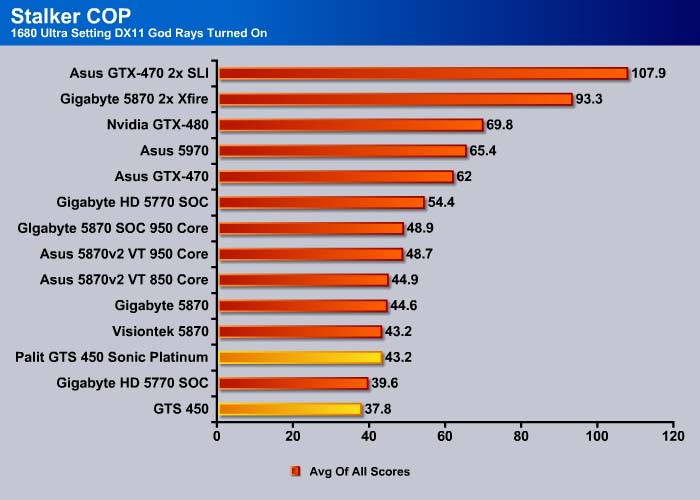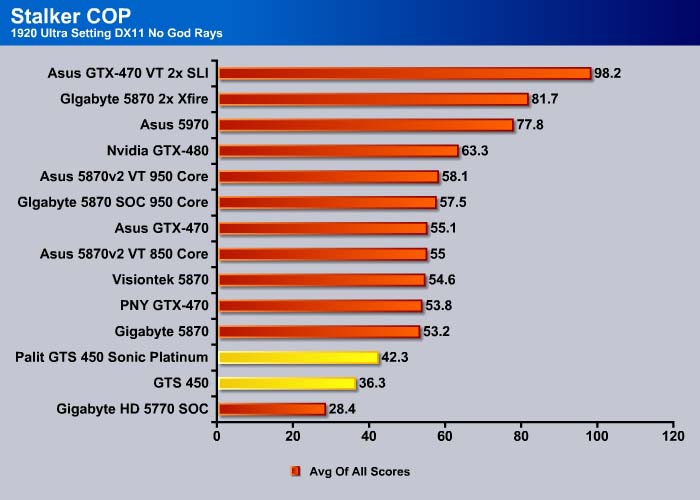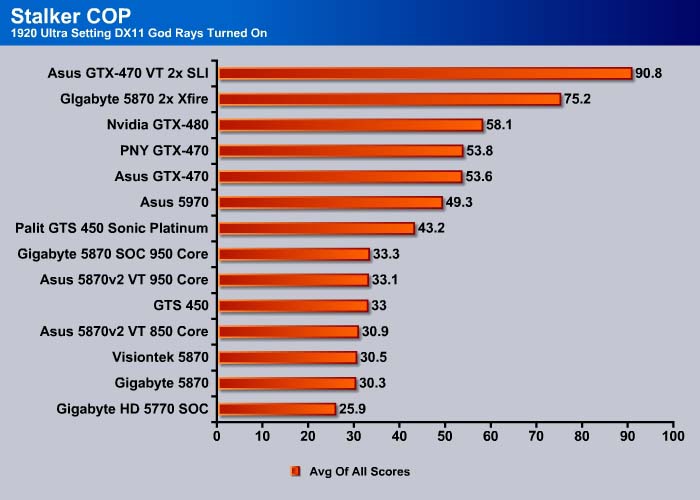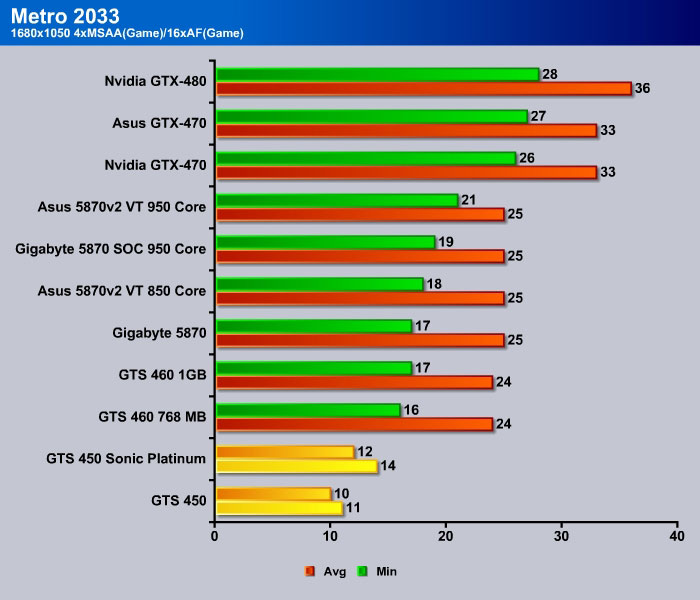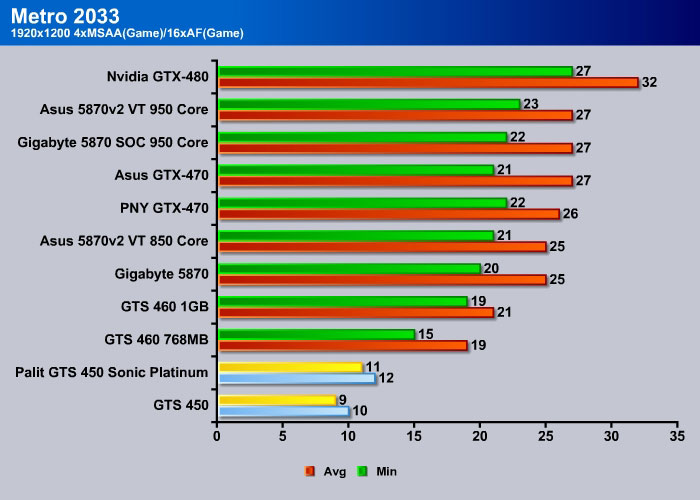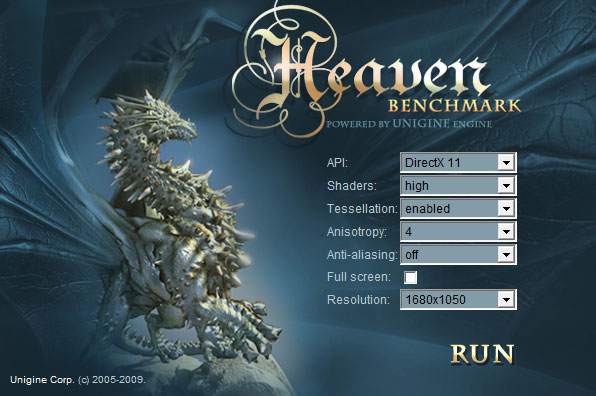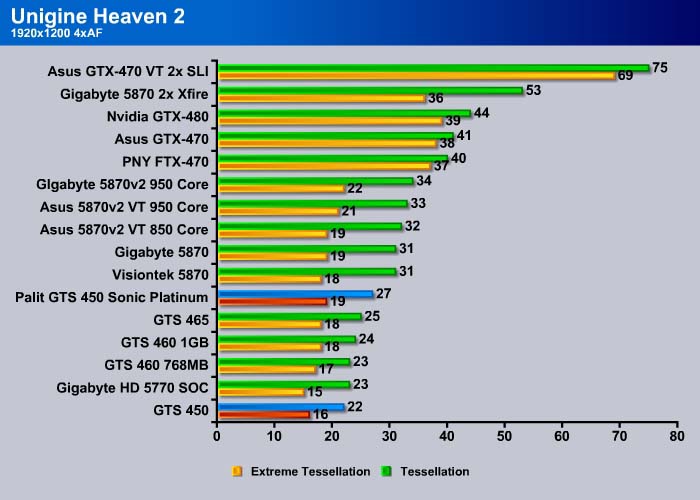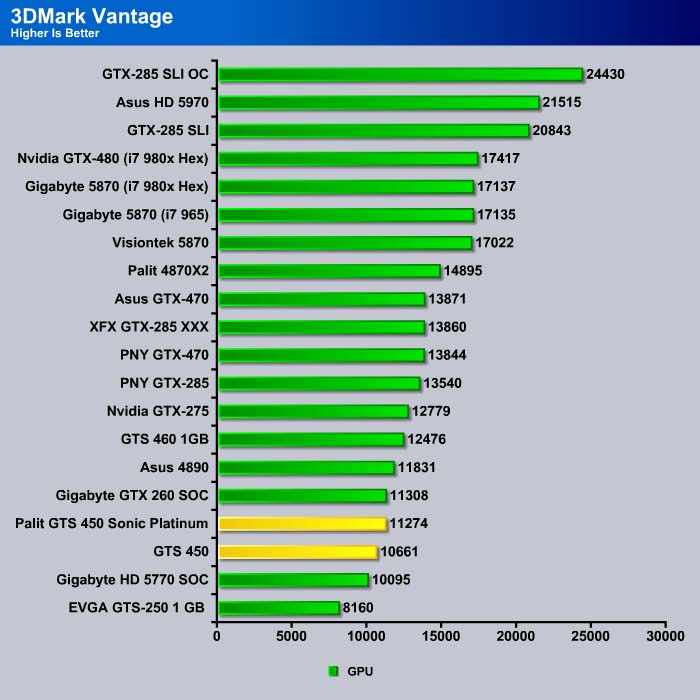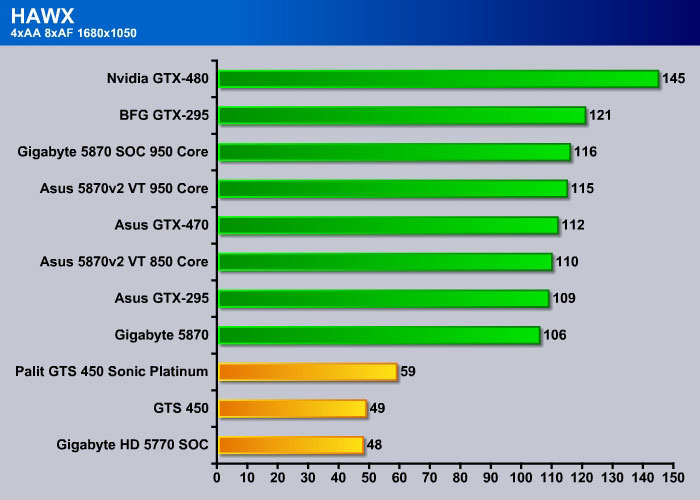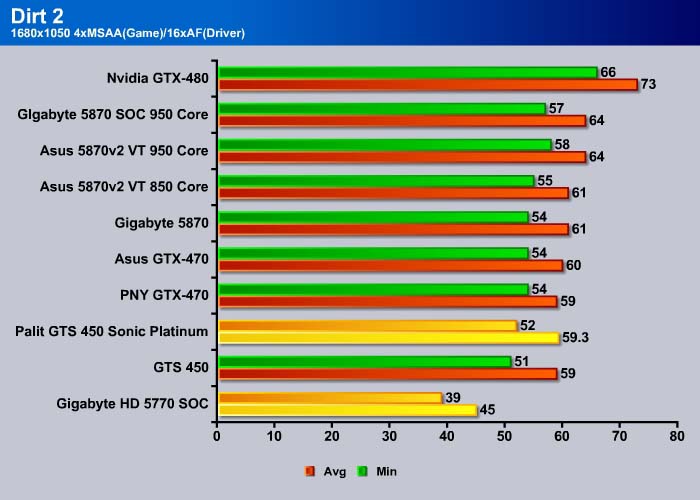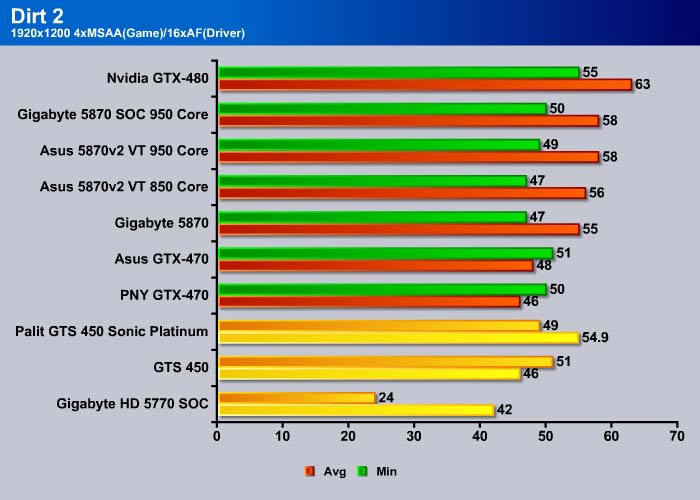The Palit GTS 450 is one of the fastest factory overclocked GTS 450’s available, with great performance and an excellent noise level that is sure to please HTPC users.
INTRODUCTION
Since the release of the GeForce 8 series in 2006, Nvidia has used the same entry-level and mainstream graphic architecture. A few minor tweaks and die shrinks have evolved the original entry-level GeForce 8600 GTS into the GeForce 9600 and the subsequent GTS 240. Though these tweaks bring better performance and lower heat output, the aging architecture and lack of DirectX 11 support are rendering them obsolete. Additionally, this has put Nvidia behind its main competitor, as AMD has offered DX11 support to its entry level cards since the release of their HD 5700 series back in October 2009.
Though Nvidia released the GeForce 200 series for the high-end market back in 2008, they never made any mainstream and budget card off that architecture, in part due to high production costs. Now, Nvidia is in dire need of a mainstream and budget lineup with new architecture that can compete against AMD’s DX11 compliant HD 5770. Today, after four years of little action, Nvidia released the GTS 450 based on the Fermi architecture, with full DirectX 11 support.
Nvidia’s Fermi architecture, launched in April 2010, gave rise to the GTX 470 and GTX 480. The Fermi was an engineering ambition from Nvidia. With 512 stream processors (32 cores per stream multiprocessor) and 3.0 billion transistors, the Fermi is huge and costly to produce. Thus, it was simply not feasible for Nvidia to produce mainstream and budget cards with the original Fermi architecture. The original Fermi is designed with a list of features such as double-precision support and ECC memory support that are not needed when playing games. Therefore, NVIDIA has cut out some of this fat, and produced a smaller, cheaper, and more efficient GF104 for the GTX 460 and GTX 465 which was released in July 12, 2010. The release of the GF104 was a good decision on Nvidia’s part, because the card runs much cooler than the Fermi, and it also is able to compete against AMD HD 5830.
With the success of the GF104, Nvidia is ready to bring all of their entire graphic cards lineups to DirectX 11 support. Up until now, the only entry-level DirectX 11 card on the market was the AMD such as the HD 5770. Nine months later, Nvidia released the GTS 450 based on GF106, a trimmed GF104. How does it stand up against the competition? Is it worth upgrading an existing DX 10 card to the GTS 450?
Meet the GTS 450
The GF160 shares the same Fermi architecture, but it is more closely related to the cut down version of the GF104 that was used in the GTX 460/GTX 465. In essence, the GF106 is the GF104 cut in half. Instead of the two GPCs (graphics processing clusters) found on the GF104 , the GF106 only has one. To give this some perspective, the original Fermi GF100 has four.
| GPU | GTX-480 | GTX-470 | GTX-465 | GTX-460 1GB | GTX-460 768MB | GTS-450 | GTX-295 | 5970 |
|---|---|---|---|---|---|---|---|---|
| Shader units | 480 | 448 | 352 | 336 | 336 | 192 | 2x 240 | 2x 1600 |
| ROPs | 48 | 40 | 32 | 32 | 24 | 16 | 2x 28 | 2x 32 |
| GPU | GF100 | GF100 | GF100 | GF104 | GF104 | GF106 | 2x GT200b | 2x Cypress |
| Transistors (approx) | 3200M | 3200M | 2336M | 2240M | 2240M | 1400M | 2x 1400M | 2x 2154M |
| Memory Size | 1536 MB | 1280 MB | 1024 MB | 1024 MB | 768 MB | 1024 MB | 2x 896 MB | 2x 1024 MB |
| Memory Bus Width | 384 bit | 320 bit | 256 bit | 256 bit | 192 bit | 128 bit | 2x 448 bit | 2x 256 bit |
| Core Clock | 700 MHz | 607 MHz | 607 MHz | 675 MHz | 675 MHz | 783 MHz | 576 MHz | 725 MHz |
| Memory Clock | 924 (X4) MHz | 837 (X4) MHz | 802 (x4) MHz | 900 (x4) MHz | 900 (x4) MHz | 902 (x4) MHz | 999 MHz | 1000 (x4) MHz |
| Price | $499 | $319 | $250 | $229 | $199 | $129 | $500 | $599 |
The number of Polymorph engines has been cut down to 4, instead of the 7 found on the GTS 460. There are four Streaming Multiprocessor (SM) units on the GF106. Each SM unit contains 8 texturing filter units for a total of 32 texturing units. Since the core architecture is based on the GF104, each SM has 48 CUDA cores (instead of 32 found on the GF100) for a total of 192 cores.
As expected, the card does not support ECC, though this is not a major deal for the consumer market. In contrast to the GF104’s three memory controllers, the GF106 has two with a 256KB shared L2 cache. The GTS 450 will come with either 1GB or 2GB of GDDR5 with 128bit bus width at effective 3608 MHz. This works out to be a total of 57.73 GB/s of total memory bandwidth, which is half of the 1GB version of the GTS 460.
The card has a maximum TDP of 106W so it only requires a single 6-pin PCIE power connector. This means that it will most likely work with existing power supplies. As for the SLI support, the card supports only 2-way SLI.
The GTS 450 takes up two slots. The cooler on the GTS 450 resembles that of the GTS 460, with a fan placed in the center of the card. We already know that the GTS 460 runs fairly cool, so the similar fan design means the GTS 450 should have very low heat output as well.
The reference designed card will come with two dual-link DVI ports and a mini-HDMI port. Though, we expect various vendors will most likely pair the card with other ports. Like the rest of the 400 series, you can only use two ports simultaneously.
The card supports DirectX 11, NVIDIA 3D Vision and True-HD audio bitstreaming.The GTS 450 will be priced at $129, and is aimed to replace the GTS 250. Nvidia’s own internal benchmark shows that the card offers up to a 23% performance increase over the GTS 250, and 31% over the HD Radeon 5750 in StarCraft II.
ForceWare 260
Nvidia often introduces new drivers when they release a new product. In addition to the performance improvements, the new ForceWare 260 driver also brings a much-needed new installer with ability to customize installation.
The new installation features one-click express and advanced custom installation, where users can choose which driver components to install. Also, Nvidia finally included a complete uninstallation program built directly into the driver. Users no longer need to run third party tools, such as DriverCleaner or DriverSweeper, to uninstall the older driver.
The new driver also features updated user interface for easier and faster NVIDIA Surround and 3D Vision adjustment. If you recall, NVIDIA Surround is NVIDIA’s multiple display technology. ForceWare 260 adds a new help page for resolution selection, a new bezel correction, and allows extra GPU for PhysX or a fourth display. The new driver also includes 3D Vision driver so user no longer need to install a separate driver.
Palit GTS 450 Sonic Platinum
We received our review sample on the day of the release, which is why we could not release this review by the launch day. The Palit GTS 450 Sonic Platinum is one of the fastest overclocked GTS 450 users can buy. At a retail price of $160, it is $30 more expensive than the reference clocked GTS 450, and it is one of the more expensive GTS 450 cards on the market. Putting the price into perspective, the GTS 460 can be purchased at about $199, so it would be interesting to see how the GTS 450 performs against the slightly more expensive card.
Palit actually has three models of GTS 450 to choose from: a Sonic Platinum, a Sonic, and a low profile version. Our review sample, the Sonic Platinum, is clocked at 900 MHz instead of the 783MHz found on the reference card. It comes with 1GB of GDDR5. While the reference GTS 450 comes with two dual-link DVI ports and a single mini HDMI port, the GTS 450 Sonic Platinum has two DVI ports, a VGA port, and a full size HDMI port. This is a very welcome change, because mini-HDMI is not widely available yet. This also eliminates the hassle of using a DVI-to-HDMI/mini-HDMI adapter.
Visually, it’s a bit odd to see a red PCB on an Nvidia card, as often we often associate the red PCB color with ATI cards. The Palit card is actually 1 inch shorter than the reference GTS 450. We get an idea of this when we compare it with the HD5770. At only 7.4’’ in length, users should have no trouble fitting the Sonic Platinum into their case. The card, however, does requires two slot spaces, a growing trend among midrange/budget cards nowadays. This is unfortunate, as many users don’t have two slots to spare in their cases.
One of the negative aspects of this card are a slight but possible warping of the PCB due to lack of structural reinforcement. The free-standing heatsink bolted to the card near the GPU core lacks any support, sometimes bending PCB. Luckily, we did not face this issue with the Palit card, due to the large copper plate that Palit includes on the GPU. This allows the stress to be distributed across the plate, keeping the PCB from bending. The plastic cooler cover further functions as an anchor to keep the card from bending.
Palit uses Samsung GDDR5 memory on their card.
Palit’s card comes with relatively few accesories: the driver disk, a quick installation guide, and a Molex power adapter. Furthermore, Palit offers a slightly shorter warranty than other manufacturers: only two years instead of the three that we find with Asus or Gigabyte cards. We were surprised that after increasing the price by $30, Palit decreased the warranty on the card.
At $160, the Palit card is considerably more expensive than other GTS 450’s. It is $30 more than the reference 450. This pricing could hurt Palit, due to the distinctly shorter warranty, and lack of bundles or overclocking tools that are usually found with other cards. Furthermore, the GTS 460 768 MB can be purchased for only $10 more, which could make it difficult for Palit to sell the card at its current price. However, as we’ll later, the Palit card is one of the most unique cards we’ve tested, so it may have a special niche that it could fill, such as the HTPC market.
TESTING & METHODOLOGY
To test the Palit GTS 450 Sonic Platinum, we did a fresh load of Windows 7 Ultimate, applied all the updates we could find, installed the latest motherboard drivers for the Gigabyte EX58-UD4P, updated the BIOS, and loaded our test suite. We didn’t load graphic drivers because we wanted to pause to clone the HD with the fresh load of Windows 7 without graphic drivers. That way we have a complete OS load with testing suite and it’s not contaminated with GPU drivers. Should we need to switch GPU’s or run some Crossfire action later all we have to do is clone our clone and install GPU drivers and we are good to go.
We ran each test a total of 3 times and report the average here. In the case of a screenshot of a benchmark we ran the benchmark 3 times, tossed out the high and low and post the median result from the benchmark. Anomalous results were discounted, and the test was rerun.
Test Rig
| Test Rig “Quadzilla” |
|
| Case Type | None |
| CPU | Intel Core I7 920 |
| Motherboard | Gigabyte EX58-UD4P |
| Ram | Kingstone HyperX 1600 |
| CPU Cooler | Prolimatech Megahalem |
| Hard Drives | Seagate 7200.11 1.5 TB |
| Optical | None |
| GPU | Palit GTS 450 Sonic Platinum Gigabyte HD 5770 Super Overclock Asus HD 5870 Matrix Platinum GIgabyte HD5870 Super Overclock Asus GTX-470 Voltage Tweak Edition PNY GTX-470 Nvidia GTX-480 Asus 5970 Visiontek HD Radeon 5870 Gigabyte HD Radeon 5870 Gigabyte HD Radeon 4890 OC Asus HD Radeon 4890 Voltage Tweak Edition PNY GTX-285 Performance Edition XFX GTX-285 XXX BFG GTX-295 Asus GTX-295 XFX 9800 GTX+ Black Edition BFG GTX-260 MaxCore Palit HD Radeon 4870X2 Sapphire HD Radeon 4870 512MB Diamond HD Radeon 4870 1 GB Sapphire HD Radeon 4850 Toxic Drivers for Nvidia GPU’s 197.41 Drivers for ATI GPU’s 10.5 |
| Case Fans | 120mm Fan cooling the mosfet CPU area |
| Docking Stations | None |
| Testing PSU | Cooler Master UCP 900W |
| Legacy | None |
| Mouse | Microsoft Intellimouse |
| Keyboard | Logitech Keyboard |
| Speakers | None |
Synthetic Benchmarks & Games
| Synthetic Benchmarks & Games | |
| 3DMark Vantage | |
| World In Conflict Benchmark | |
| Crysis v. 1.2 | |
| Dirt 2 | |
| FarCry 2 | |
| Stalker COP | |
| Crysis Warhead | |
| Unigine Heaven v.2.0 | |
| FurMark | |
We ran a very comprehensive battery of tests, including DX9, DX10, DX11, Tessellation, and many others. We wanted as wide a representative sample as possible in the time available.
Crysis v. 1.21
Crysis was the most highly anticipated game to hit the market in the last several years. Crysis is based on the CryENGINE™ 2 developed by Crytek. The CryENGINE™ 2 offers real time editing, bump mapping, dynamic lights, network system, integrated physics system, shaders, shadows, and a dynamic music system, just to name a few of the state-of-the-art features that are incorporated into Crysis. As one might expect with this number of features, the game is extremely demanding of system resources, especially the GPU. We expect Crysis to be a primary gaming benchmark for many years to come.

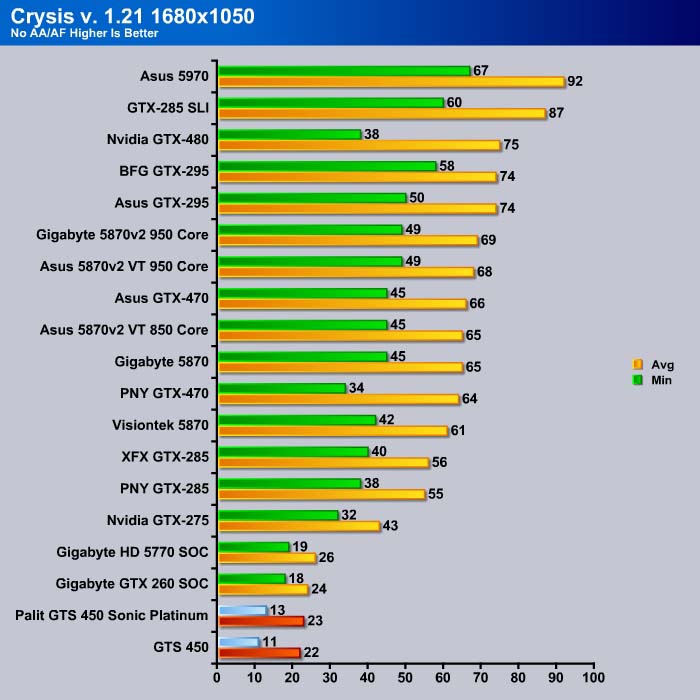
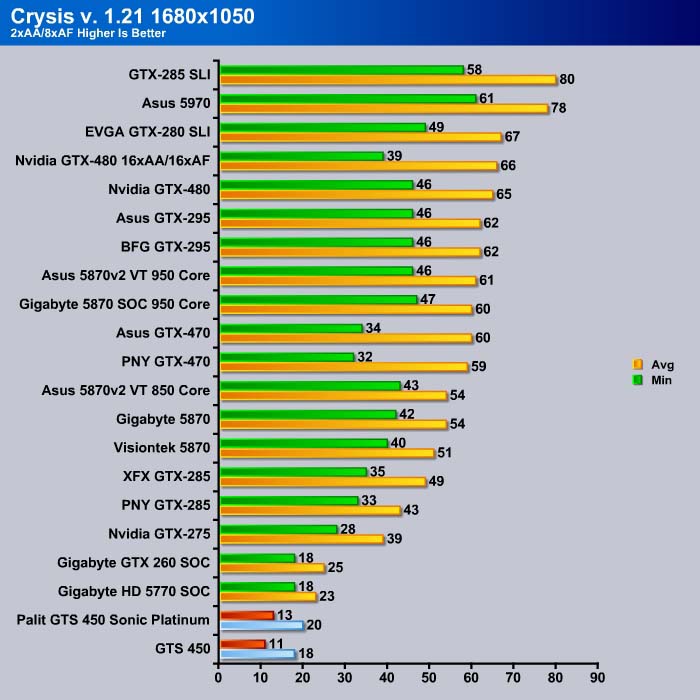

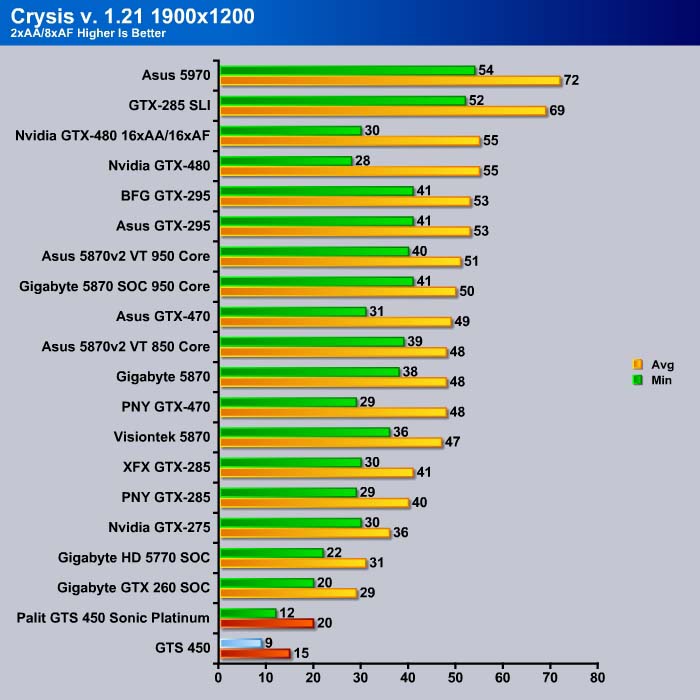
CRYSIS WARHEAD
Crysis Warhead is the much anticipated standalone expansion pack to Crysis, featuring an updated CryENGINE™ 2 with better optimization. It was one of the most anticipated titles of 2008.

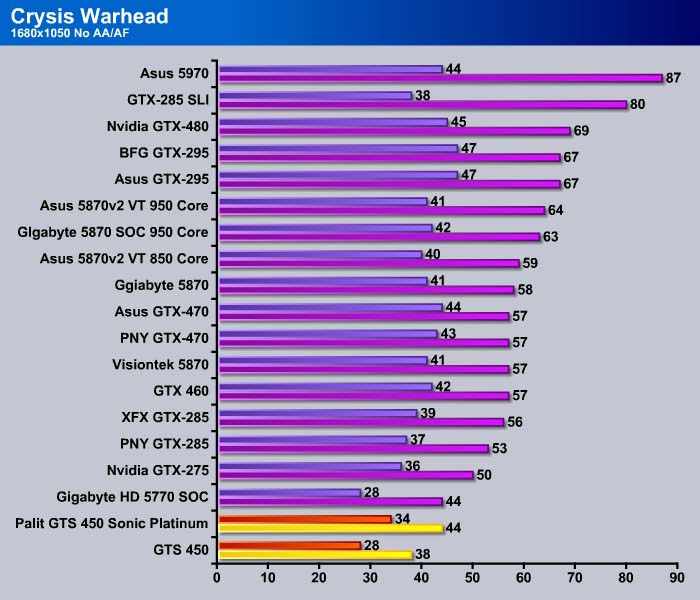
At 1680×1050, the stock GTS 450 barely hangs on with a minimum 28 FPS, just enough to play the game. However, our overclocked card is able to push the game to minimum 34 FPS, enough for a smooth game play. It also is able to yield 44 average FPS. In fact, at this resolution, the GTS 450 SP is actually able to beat out the HD 5770.
When we enable the AA, the GTS 450 SP averages out 1 frame faster than the HD 5770 and 4 frames faster than the stock card.
As we turn up the resolution, we to see the overclocked GTS 450 SP putting out 6 more frames than the reference card. Its performance is equal to our overclocked HD 5770 from Gigabyte.
As we increase the visual effect, the overclocked GTS 450 edges out the HD 5770 SOC by 1 frame/second.
Far Cry 2
Far Cry 2, released in October 2008 by Ubisoft, was one of the most anticipated titles of the year. It’s an engaging state-of-the-art First Person Shooter set in an un-named African country. Caught between two rival factions, you’re sent to take out “The Jackal”. Far Cry 2 ships with a full featured benchmark utility and it is one of the most well designed, well thought out game benchmarks we’ve ever seen. One big difference between this benchmark and others is that it leaves the game’s AI (Artificial Intelligence) running while the benchmark is being performed.
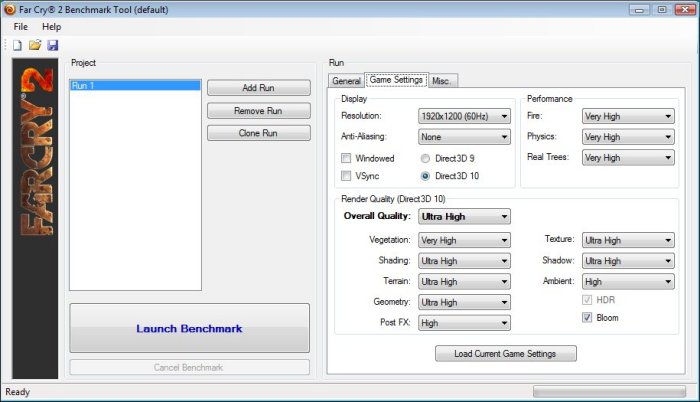 The Settings we use for benchmarking FarCry 2
The Settings we use for benchmarking FarCry 2
Right from the start, we see that the GTS 450 outperforms the HD 5770. With overclocking, the card is able to yield 20% higher performance and overtake the GTX 260.
Even when we increase the visual effect, the GTS 450 SP is still able to hold its position over the GTX 260 and HD 5770.
At higher resolution, the GTS 450 SP offers 15% greater performance over the stock GTS 450 and the overclocked HD 5770.
The extra memory and overclocking helps the GTS 450 SP outperform the GTX 260 SOC again at 1920 x 1200 with 4xAA.
S.T.A.L.K.E.R.: CALL OF PRIPYAT
Call of Pripyat is the latest addition to the S.T.A.L.K.E.R. franchise. S.T.A.L.K.E.R. has long been considered the thinking man’s shooter, because it gives the player many different ways of completing the objectives. The game includes new advanced DirectX 11 effects as well as the continuation of the story from the previous games.

Right from the start we see the GTS 450 comes ahead of the HD 5770, and with overclocking, the 450 SP is able to yield 10% extra performance.
When we factor in God Rays, the HD 5770 comes ahead of the GTS 450. However, the overclocked GTS 450 SP outperforms the HD 5770 with 4 extra frames.
Similar to what we saw earlier, the GTS 450 performs better than the HD 5770
Here, the overclocked GTS 450 shows 30% performance gain over the stock GTS 450.
Metro 2033
Metro 2033 is an action-oriented video game with a combination of survival horror, and first-person shooter elements. The game is based on the novel Metro 2033 by Russian author Dmitry Glukhovsky.
The enemies that the player encounters range from human renegades to giant mutated rats and even paranormal forces known only as “The Dark Ones”. Players frequently have to defend themselves with makeshift combination’s of different weapons, e.g a revolver with a sniper scope attached.
Ammunition is also scarce, and the more rare Military Grade bullets are used as currency (to purchase supplies and guns), or in combat as a last resort, giving an added damage boost, forcing the player to hoard supplies.
The game lacks a health meter, relying on audible heart rate and blood spatters to show the player what state they are in and how much damage was done. A gas mask must be worn at all times when exploring the surface due to the harsh air and radiation. There is no on-screen indicator to tell how long the player has until the gas mask’s filters begin to fail, so players must set a wrist watch, and continue to check it every time they wish to know how long they have until their oxygen runs out, requiring the player to replace the filter (found throughout the game). The gas mask also indicates damage in the form of visible cracks, warning the player when a new mask is needed. The game does feature traditional HUD elements, however, such as an ammunition indicator and a list of how many gas mask filters and adrenaline shots remain.
Metro 2033 is one of the most demanding games on the market right now. As we can see here, the GTS 450 performs as expected, behind the GTS 460. Our GTS 450 SP is able to offer 20% higher performance over the stock GTS 450.
Unigine Heaven 2.0
Unigine Heaven is a benchmark program based on Unigine Corp’s latest engine, Unigine. The engine features DirectX 11, Hardware tessellation, DirectCompute, and Shader Model 5.0. All of these new technologies combined with the ability to run each card through the same exact test means this benchmark should be in our arsenal for a long time.
The settings we used in Unigine Heaven
The GTS 450 performs quite well in this benchmark, outperforming the HD 5770. With overclocking, the GTS 450 SP is able to gain 5 extra frames.
The Tesselation portion of Unigine Heaven is very taxing on video cards, so the GTS 450 falls behind the HD 5770. However, with overclocking, we can see the Sonic Platinum from Palit is capable of outperforming the GTS 460.
3DMark Vantage
For complete information on 3DMark Vantage Please follow this Link:
www.futuremark.com/benchmarks/3dmarkvantage/features/
The newest video benchmark from the gang at Futuremark. This utility is still a synthetic benchmark, but one that more closely reflects real world gaming performance. While it is not a perfect replacement for actual game benchmarks, it has its uses. We tested our cards at the ‘Performance’ setting.
3DMark Vantage places the GTS 450 ahead of the HD 5770 and the GTS 250. The GTS 450 SP scored 613 points more than the stock GTS 450.
HawX
The story begins in the year 2012. As the era of the nation–state draws quickly to a close, the rules of warfare evolve even more rapidly. More and more nations become increasingly dependent on private military companies (PMCs), elite mercenaries with a lax view of the law. The Reykjavik Accords further legitimize their existence by authorizing their right to serve in every aspect of military operations. While the benefits of such PMCs are apparent, growing concerns surrounding giving them too much power begin to mount.
Tom Clancy‘s HAWX is the first air combat game set in the world–renowned Tom Clancy‘s video game universe. Cutting–edge technology, devastating firepower, and intense dogfights bestow this new title a deserving place in the prestigious Tom Clancy franchise. Soon, flying at Mach 3 becomes a right, not a privilege.
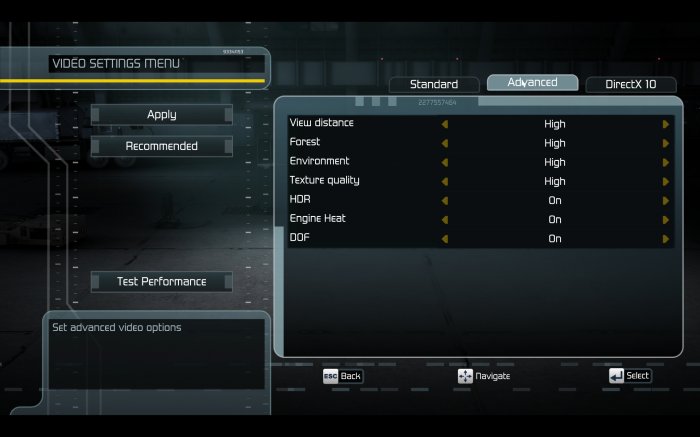
While the stock GTS 450 performance is similar to the HD 5770, the overclocked card is able to yield 10% higher performance. By now, we can see a trend where the overclocked Sonic Platinum is able to yield 10~30% higher performance over the reference card. It also often outperforms the HD 5770.
Surprisingly, at this resolution, we do not see any performance gain for our GTS 450 SP. However, we can see that GTS 450 still edges out the HD 5770.
Dirt 2
Colin McRae: Dirt 2 (known as Dirt 2 outside Europe and stylized, DiRT) is a racing game released in September 2009, and is the sequel to Colin McRae: Dirt. This is the first game in the McRae series since McRae’s death in 2007. It was announced on 19 November 2008 and features Ken Block, Travis Pastrana, Tanner Foust, and Dave Mirra. The game includes many new race-events, including stadium events. Along with the player, an RV travels from one event to another, and serves as ‘headquarters’ for the player. It features a roster of contemporary off-road events, taking players to diverse and challenging real-world environments. The game takes place across four continents: Asia, Europe, Africa and North America. The game includes five different event types: Rally, Rallycross, ‘Trailblazer,’ ‘Land Rush’ and ‘Raid.’ The World Tour mode sees players competing in multi-car and solo races at new locations, and also includes a new multiplayer mode.
Colin McRae: Dirt is the first PC video game to use Blue Ripple Sound’s Rapture3D sound engine by default.
A demo of the game was released on the PlayStation Store and Xbox Live Marketplace on 20 August 2009. The demo appeared for the PC on 29 November 2009; it features the same content as the console demo with the addition of higher graphic settings and a benchmark tool.
In Dirt 2, the GTS 450 shows very good performance over the HD 5770. The Palit GTS 450 SP does not display as much performance gain as what we have observed previously.
Overclocking
For overclocking, we used the latest version of EVGA Precision tool, since Palit does not include any overclocking tool with their card. Since our sample is comes with one of the highest factory overclock speeds there is, we do not expect much gain. At the end, we were still able to squeeze 30MHz frequency out of the GPU core and 90 MHz frequency out of the memory, not a terrible result, considering the already high performance of this card. Even at this speed, the card still runs cool and also very quiet.
POWER CONSUMPTION
To get our power consumption numbers we plugged in our Kill A Watt power measurement device and took the Idle reading at the desktop during our temperature readings. We left it at the desktop for about 15 minutes and took the idle reading. Then we ran FurMark for 10 minutes and recorded the highest power usage.
| GPU Power Consumption | |||
| GPU | Idle | Load | |
| Palit GTS 450 Sonic Platinum | 130 Watts | 275 Watts | |
| Gigabyte HD 5770 SOC | 157 Watts | 269 Watts | |
| Asus HD 5870 Matrix Platinum | 164 Watts | 385 Watts | |
| Gigabyte HD5870 SOC |
169 Watts | 391 Watts | |
| Asus GTX-470 | 181 Watts | 488 Watts | |
| PNY GTX-470 | 178 Watts | 487 Watts | |
| Nvidia GTX-480 | 196 Watts | 521 Watts | |
| Gigabyte HD5870 | 167 Watts | 379 Watts | |
| Asus EAH5970 | 182 Watts | 412 Watts | |
| Gigabyte 4890 OC | 239 Watts | 358 Watts | |
| Asus EAH4770 | 131 Watts | 205 Watts | |
| BFG GTX-275 OC | 216 Watts | 369 Watts | |
| Nvidia GTX-275 Reference | 217 Watts | 367 Watts | |
| Asus HD 4890 Voltage Tweak Edition | 241 Watts | 359 Watts | |
| EVGA GTS-250 1 GB Superclocked | 192 Watts | 283 Watts | |
| XFX GTX-285 XXX | 215 Watts | 369 Watts | |
| BFG GTX-295 | 238 Watts | 450 Watts | |
| Asus GTX-295 | 240 Watts | 451 Watts | |
| EVGA GTX-280 | 217 Watts | 345 Watts | |
| EVGA GTX-280 SLI | 239 Watts | 515 Watts | |
| Sapphire Toxic HD 4850 | 183 Watts | 275 Watts | |
| Sapphire HD 4870 | 207 Watts | 298 Watts | |
| Palit HD 4870×2 | 267 Watts | 447 Watts | |
| Total System Power Consumption | |||
AMD’s latest HD 5000 series often has low idle power consumption, but as we can see, the GTS 450 is able to beat that. Our GTS 450 Sonic Platinum card is factory overclocked, and yet only consumes 130 watts of power (27 watts less than the HD 5770). Under full load, the GTS 450 SP consumes 6 more watts than the HD 5770, which given the performance of the GTS 450 SP, is very good.
TEMPERATURES and noise level

Equally impressive is the temperature performance of the GTS 450 SP. Under idle, the card runs at cool 35°C and even under load using FurMark, it only runs up to 73°C. FurMark uses unrealistic conditions to create a worst case scenario, producing the highest temperatures possible. Users should expect the GTS 450 SP to run cool inside of their computers.
Regarding to the noise level, this card runs extremely quiet. Under load, the fan only running at 30% (~1300 RPM) and even under load (73°C), the fan will still only runs under 50% at ~2000 RPM. At this level, the noise is barely audible. In fact, our CPU fan is louder than the card’s fan noise. We love the fact that the card is able to run so cool at such low noise level. This is one of the biggest advantages the Palit GTS 450 SP has over other cards at its price range.
CONCLUSION
The launch of the GTS 450 prompted AMD to lower the price of the HD 5770 to compete against the GTS 450’s $130 price tag. While the reference GTS 450 is often able to perform at the level of the HD 5770, it does sometimes fall slightly behind. This is where the overclocked GTS 450 is able to take the reins. Our Palit GTS 450 Sonic Platinum is one of the fastest factory overclock GTS 450 money can buy. As we can see, while the reference card battles the HD 5770 for its spot in line, the Sonic Platinum is able to beat the HD 5770 in every single benchmark except Crysis. It is definitely one of the best cards in terms of performance. The Palit GTS 450 Sonic Plantinum is able to yield approximately 10~30% performance gain over the reference card depending on the game setting and the benchmarks.
At price tag of $160, the Sonic Platinum is unfortunately $30 more expensive than the GTS 450 or the HD 5770, and it comes close to the GTS 460’s price tag of $199. In fact, those shopping online can find a GTS 460 with a rebate that brings the 460’s price to only $10 more than the GTS 450 Sonic Platinum. The GTS 450 Sonic Platinum’s price becomes a little hard to swallow, considering that the GTS 460 offers significantly higher performance.
The Palit GTS 450 Sonic Platinum does have some advantages over its competitor, though, the least of which are its noise level and size. The Palit card is smaller than other GTS 450 (possibly the smallest among the cards at similar price range) and is the quietest we have tested. Therefore, it fits very well for those who want a quiet system, or are running HTPCs. As we can see, the card is capable of offering excellent performance at resolutions like 1680×1050, and it often yields playable frame rates at 1920×1080. This would be a perfect card for HTPC users who also use their media center for gaming.
| OUR VERDICT: Palit GTS 450 Sonic Platinum | ||||||||||||||||||
|
||||||||||||||||||
| Summary: The Palit GTS 450 Sonic Platinum offers good performance gain over the reference GTS 450. Even more impressive is its power consumption and low noise level. Though slightly more expensive than other GTS 450’s, it is an ideal card those who wish to have a quiet system. We are proud to give it the Bjorn3D Silver Bear Award. |
 Bjorn3D.com Bjorn3d.com – Satisfying Your Daily Tech Cravings Since 1996
Bjorn3D.com Bjorn3d.com – Satisfying Your Daily Tech Cravings Since 1996

